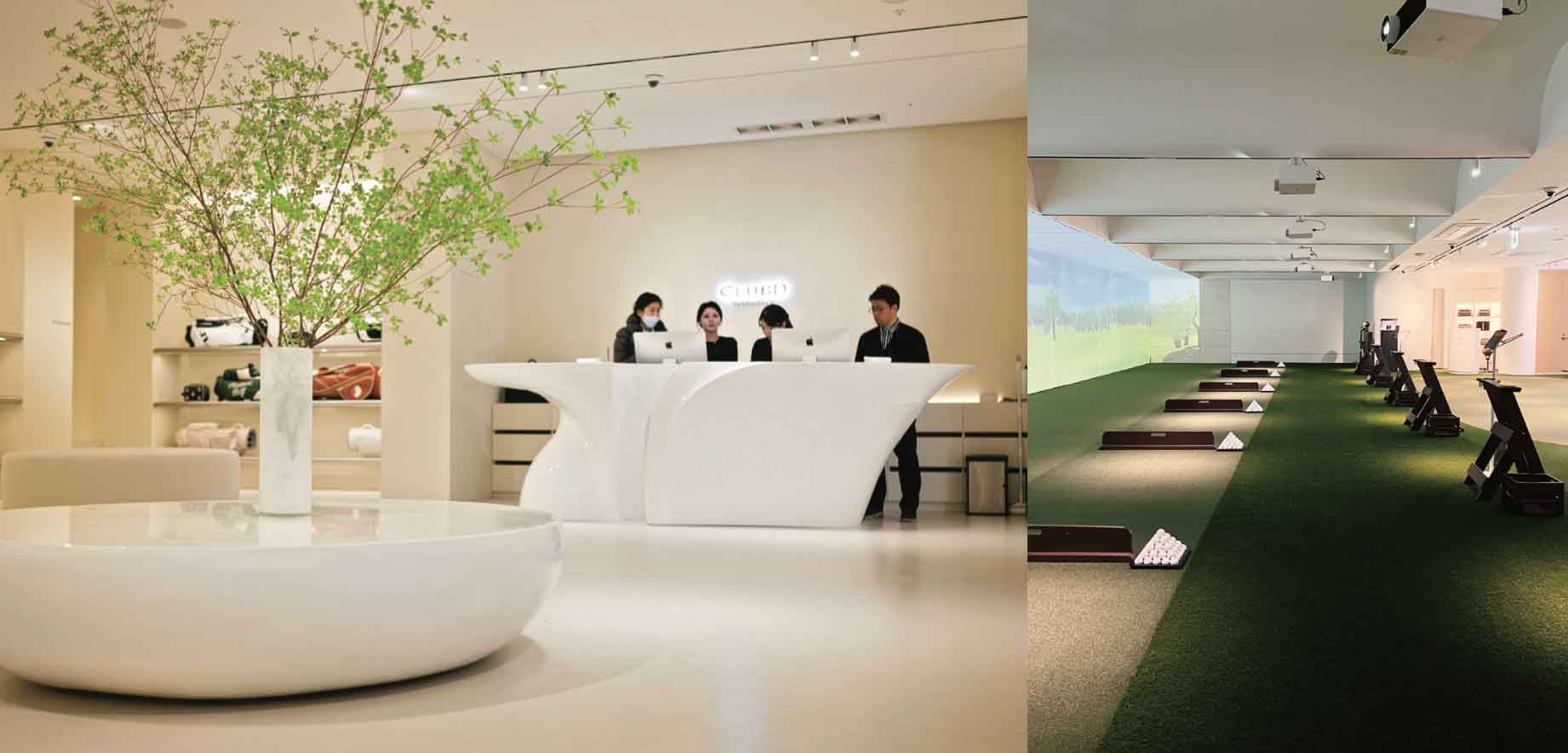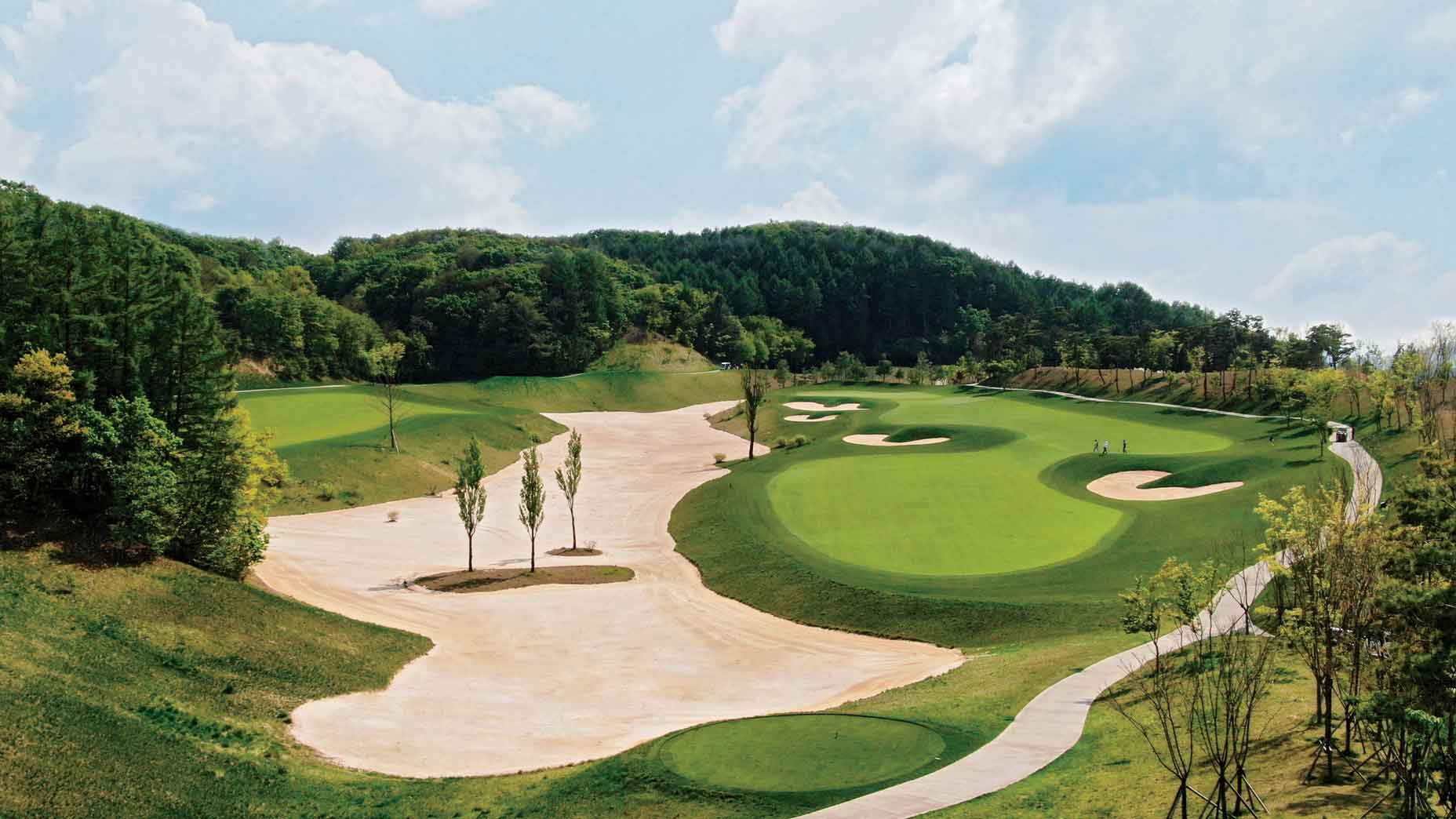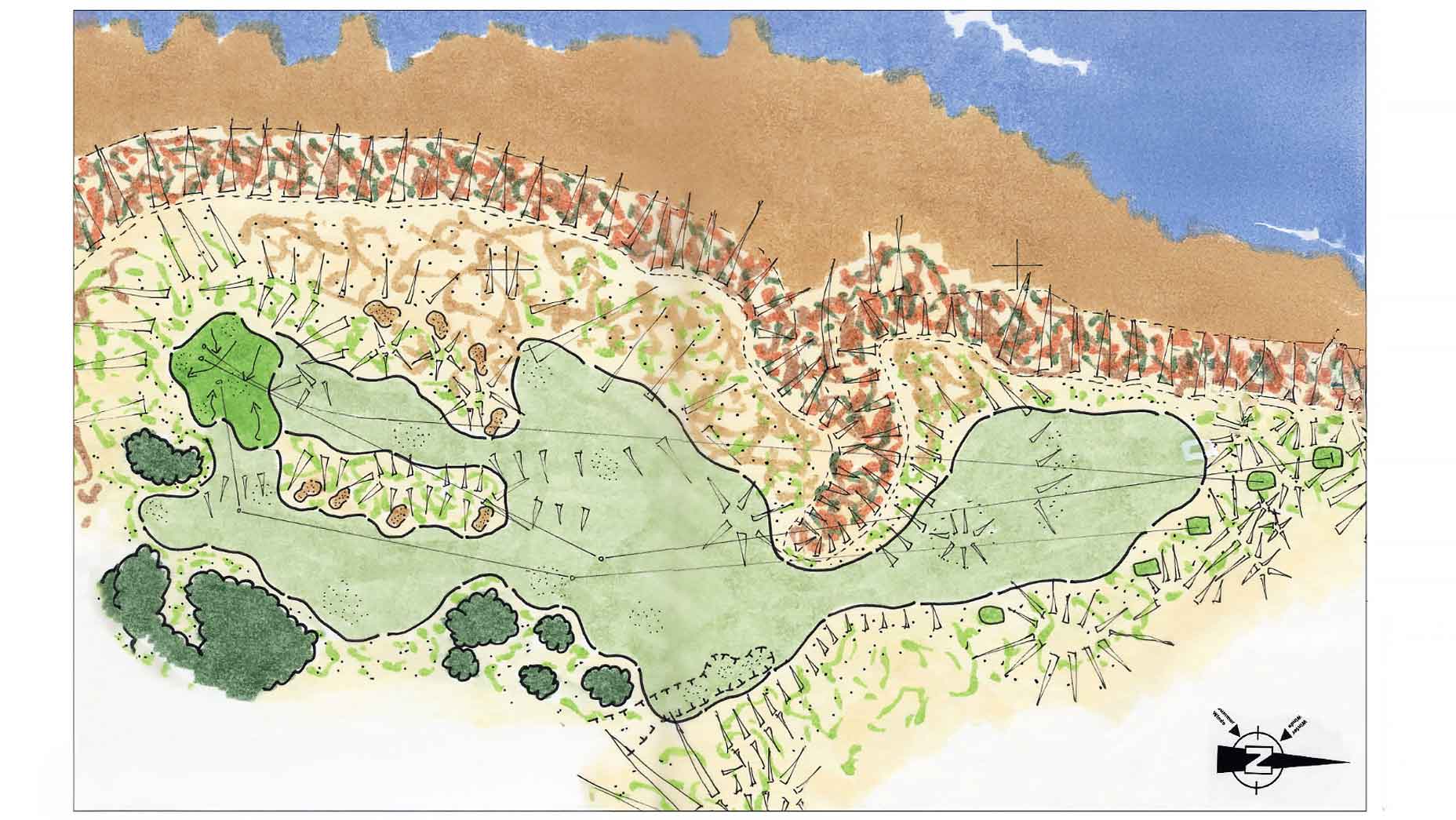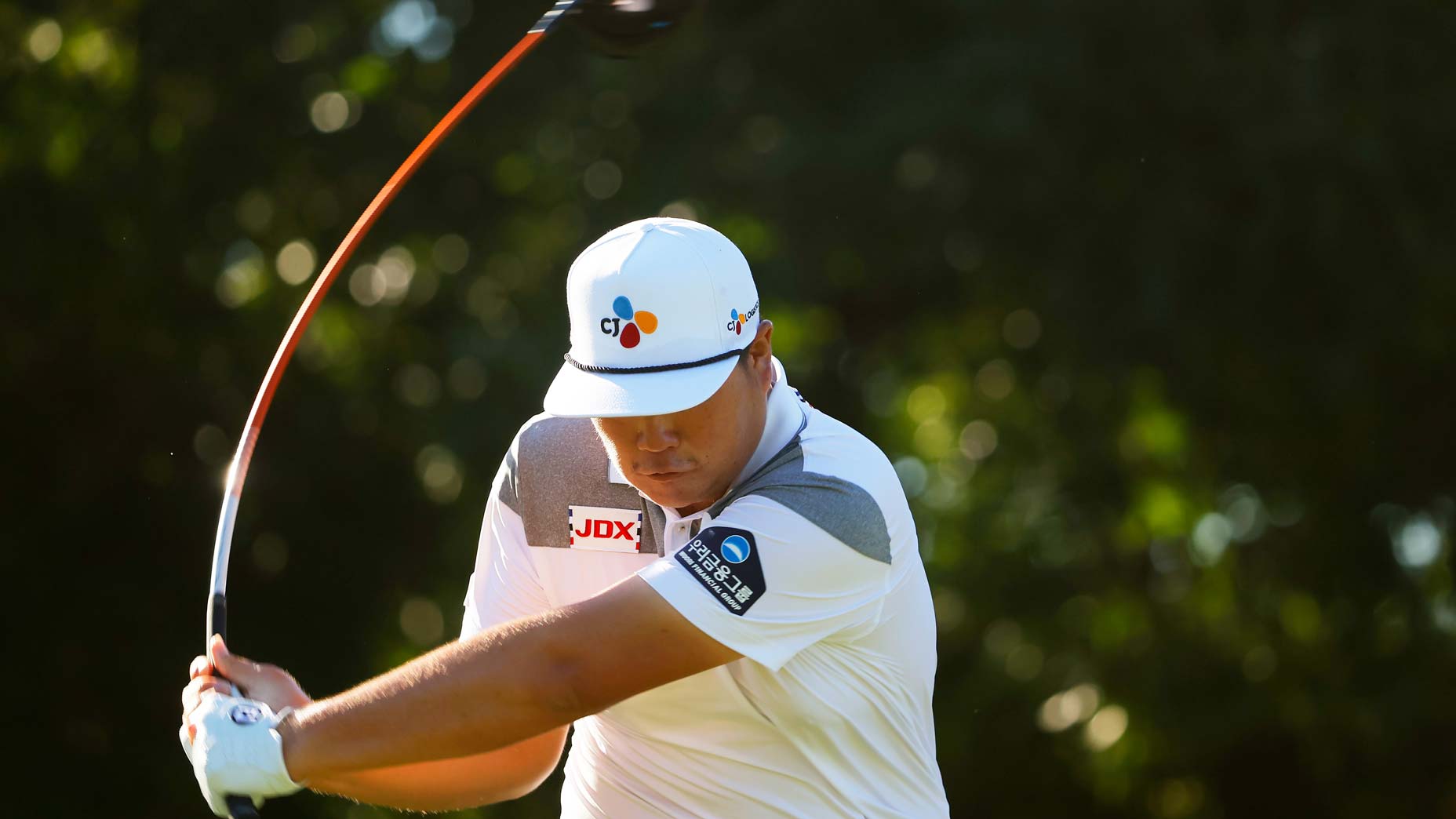In South Korea’s capital city you can barely walk a block without running into a neon-lit driving range, a jam-packed simulator joint or a sign — in fashion, in business, in culture, in the pro ranks — that this golf-mad nation will ever stop swinging for… the nets.
***
On a sweltering afternoon in Seoul’s Gangnam district, the most expensive zip code in South Korea, I’m standing outside Pastel Golf Club when a Maserati pulls up to the bag drop, easing to a stop behind a Lamborghini. A young man in neon golf attire hops out.
An attendant grabs his sticks — gold-plated PXGs, custom Scotty Cameron putter — while another staffer bows and grabs the clubhouse door. It’s a grand entrance for a guy who’s come to hit balls off a mat into a net.
“As you can see,” Jin-Woo Kim tells me through a translator as the man walks by, “this is a premium experience.”
Slender and dapper in a dark black suit, Kim is the general manager of Pastel GC, which, despite its name, is not a golf club. It’s a driving range squeezed into a neighborhood of high-end department stores and luxury towers. Through the clubhouse lobby, Kim leads me past a restaurant and a pro shop to a practice complex, where indoor putting greens and simulator stations look out on triple-decker hitting bays. Each stall is outfitted with stat-tracking technology, and all are occupied. Balls pop up automatically on rubber tees. Drives max out, mid-flight, inside a meshed enclosure before dropping to a tarp that protects the showy cars parked in the lot below.
“We are busy like this almost all day and night,” Kim says.
There are many ways to measure golf ’s prominence in South Korea. One is to tally the number of LPGA Tour winners the country has produced (49). Another is to tick off economic stats. South Korean companies spend lavishly on golf. They own such leading brands as TaylorMade and Titleist and provide title sponsorship to several PGA Tour events. South Korean consumers punch above their weight as well, shelling out more per capita on gear and apparel than their counterparts anywhere else. It all adds up to the third-largest golf market in the world, after the United States and Japan.

No single metric, though, conveys the full story. The game’s impact across the country is cultural and economic. It rounds out business deals, influences fashion, gives shape to retail and recreation trends. In the wealthiest corners, it informs the rhythms of daily life.
Out of a population of 51 million, about one in 10 South Koreans plays golf. (In the U.S., that figure is closer to one in 13.) How they play is another matter. Mostly, they don’t play on real courses. But it’s not that South Korea lacks these options. In the past 20 years, the number of green-grass layouts in the country has nearly doubled, from around 250 to upward of 500. Many, though, are private, with initiation dues north of $1 million. And nearly all are situated far from major cities, accessible by roads that back up like rush-hour freeways in L.A.
Given the time and cost involved in getting out, a lot of golfers wind up staying in instead, hitting balls into nets and screens. Nowhere in the world are alternative forms of the game more popular. And nowhere is that popularity more apparent than in Seoul, the capital, where covered ranges rise like scaffolding on the skyline and simulator venues are as common as karaoke joints.

THEY SERVE a karaoke-like function too. In Korean, the word bang means room, and it is widely used in reference to themed-entertainment venues where people come to party and pursue a pastime, often in that order. A noraebang, for instance, is a singing room, while a PC bang is an internet cafe that draws a fair share of avid gamers. Screen-golf bangs in South Korea started gaining steam in the early aughts, propelled by a company called Golfzon, an industry disruptor that has grown into an establishment force, commanding around 60 percent of a domestic screen-golf market that generates an estimated $1.6 billion in annual revenue.
Today, Golfzon has more than 8,700 locations around the country and another 1,050 around the world, including 160 in the U.S. These venues range in size and swankiness but all revolve around rooms for sip- ping, snacking and smacking shots into screens. According to the company, some 94 million rounds were logged on Golf- zon simulators in South Korea last year, nearly twice the number of traditional rounds played nationwide.
“I fell in love with the game in a place like this,” Taehyun Kong says.
IT’S ANOTHER sauna of a day, hot and muggy. But we’re in an air-conditioned suite in an office high-rise: Golfzon’s largest location in the capital. Kong, an effervescent 31-year-old with the broad-shouldered build of the baseball standout he used to be, is standing on an artificial-turf tee, waggling a driver, taking aim at a simulated fairway. When Kong was growing up, no one in his family played golf. He didn’t touch a club until he was 15, when an injury sidelined him from the diamond and friends invited him on a screen-golf outing.
“It was so much fun,” Kong says. “I was hooked right away.”
Though Kong still plays on simulators for kicks, his passion has become his profession. He’s among the stalwarts on the GTour, the world’s first and largest professional screen-golf circuit. Launched by Golfzon in 2012, the GTour has held more than 200 tournaments and given out nearly $12 million in prize money. Its events are staged in a screen-golf stadium at Golfzon Zoimaru, a sprawling theme park about three hours from Seoul, and broadcast live on national TV.
Not even the most ardent screen-golf lovers would argue that simulated golf and real golf are the same. But they might call them complementary while pointing to statistical correlations between the two. Surveys show that 64 percent of golfers in South Korea play both forms of the game, and industry studies indicate that, over the past decade, the two sectors have grown hand in hand.
Screen golf, of course, is an easier way to get started, with lower costs — some $20 per round to rent a simulator room, depending on the time of day and location, compared to green fees that can fetch 10 times that much — and a gentler learning curve.
“No wind or rain,” Kong says. “It’s just easier to play.”

Still, the skills are transferable. This past July, the GTour golfer Hong-taek Kim, nicknamed “the King of the Screen” for his 12 wins on the circuit, claimed a green-grass victory on the Korean PGA Tour. (Many GTour golfers play the KPGA as well; others supplement their income as golf instructors and social-media influencers.) And he’s not the only screen golfer whose game can travel. Kong himself gets it around nicely on real courses. He’s a member of the Korean national golf team and a former semifinalist in the Asian Games, with a sturdy swing that he’s getting ready to show off now.
His waggle finished, Kong takes a mighty lash, launching a ball into the screen. He grins and flexes playfully. “Bryson DeChambeau!” he says, as his drive soars through a digitized sky, landing more than 300 simulated yards away.
THOUGH SOUTH KOREA has a fledgling First Tee program, it is not a country rich in grassroots golf. Very few people speak of “growing the game.” At most courses, kids aren’t allowed to play. Even elite juniors strike the bulk of their shots at academy practice ranges.
That’s where the alt-golf market comes in. In recent years, nontraditional golf venues have been going to greater lengths to reach a younger demographic. Golfzon is the biggie in the screen-golf sector, but its main competition comes from the internet conglomerate Kakao, a relative newbie to the space, whose golf simulators feature colorful animated characters. Grandpa is clearly not the target market. On the outskirts of Seoul, meanwhile, where land is less expensive than it is in the city center, tricked-out driving ranges cater to Gen Y and Zers with everything from music and glow balls to laser shows.
Among the most impressive of these youthful concepts is ShowGolf, which, fittingly, was founded by a golf industry outsider, an up-from-nothing entrepreneur named Joseph Cho. Born to a working-class family in Seoul, Cho had no contact with the game until his early 20s, when, after military service in South Korea’s special forces, he took a job in the Democratic Republic of Congo as a security guard for a diamond dealer. There, in his off-hours, he was introduced to golf on a ramshackle course.

From Africa, Cho moved to California, where he worked as a janitor in a sports stadium and a burger flipper in a fast-food joint, before returning to his home country in the early 2000s, right around the time that a course-construction boom was getting underway. Seeing an opportunity, Cho launched a tee-time booking service.
“I spent years cold-calling courses,” Cho says. “Nobody knew me. Nobody wanted to hear from me. It took me years, but I finally broke through.”
The business made Cho a wealthy man while opening his eyes to other golf-related prospects.
“Golf in Korea is a rich person’s sport,” he says. “But other people should have a chance to play it too.”
In 2019, he unveiled his first ShowGolf, a multitiered, high-tech driving range that is something like a Topgolf with a street-punk tinge. The walls are covered in graffiti. The soundtrack spans from rock to K-pop to R&B. Kids are welcome. Pets are too. Operating hours are from midmorning to 2 a.m.
“I’m trying to make it easy for everyone,” Cho says.
ShowGolf now has five locations, and Cho has become an industry insider. He runs one of the country’s largest golf-merchandise shows and recently bought a golf resort in Japan. Though he’s not a member of any fancy club, he has friends in high places and gets invited to outings often.
His participation is conditional. “I’ll play if someone else is treating,” he says. “But I’m not going to pay that kind of money to play golf.”

OTHERS FEEL the opposite. “I might play screen golf if my tee time gets rained out,” Tyler Kwon says. “But otherwise, never, really.”
It’s early morning, midweek, and Kwon is at the wheel of his white Mercedes, navigating outbound traffic on his way to play the game as he prefers to play it. His destination is Bear Creek Golf Club, one of his favorite courses, about an hour from Seoul.
A lushly maintained, water-laden layout with ample elevation changes, Bear Creek reflects the pervading course aesthetic in South Korea, where the rustic elements of modern minimalism hold little sway. This is partly due to the terrain; much of South Korea is mountainous and rocky, ill-suited to links-inspired designs. But it’s also a matter of consumer taste. As is true in much of Asia, browned-out and bouncy are not preferred conditions. Augusta-green is the favored look.
A construction company owns Bear Creek, which hints at something else about the game in South Korea: Municipal golf is close to nonexistent. The vast majority of clubs are privately owned. Quite a few belong to the country’s largest conglomerates, including Samsung, Hyundai and CJ Group. Corporate memberships abound.
Such arrangements are a natural extension of a culture in which golf and business flow seamlessly together. Unlike in the U.S., where on-course wheeling and dealing is often frowned upon, talking shop at the club is standard practice in South Korea, expected and respected.
“If you look at the foursome ahead of you,” Kwon says, “there’s a good chance it’s a CEO playing with three clients or colleagues.”
Kwon is well-connected in those circles. Born in the U.S. to Korean parents, he grew up in New York and worked on Wall Street after college before moving on to a finance job in China. Now in his early 40s, he heads his own Seoul-based private equity firm. Most weeks, he gets out at least once, playing with a small, rotating group of friends. In South Korea, it helps to have a reliable cohort. Almost without exception, courses require that tee times be booked for four and charge full freight no matter how many people wind up playing. Groups, consequently, get filled out in advance. The sight of a single on the putting green, waiting to be paired with strangers, is as rare as an albatross.
On this morning, two of Kwon’s playing partners have beaten us to Bear Creek. They’re sitting in the clubhouse when we arrive. One is Austin Na, older brother of the PGA Tour veteran-turned-LIV-golfer Kevin. Like his younger sibling, Austin grew up in Southern California, immersed in the game. “But it was pretty obvious from an early age that Kevin had more competitive drive,” Na says. “He was also just better at golf than me, so my parents basically said, Okay, Kevin’s going to be the golfer, you focus on school.”
Out of a population of 51 million, about one in 10 South Koreans play golf. How they play is another matter. Mostly, it’s not on real courses
A fine player in his own right, Na wound up carving out a different place in the industry, as a TV commentator for South Korea’s version of Golf Channel and as one of the country’s most sought-after instructors, whose stable of students includes top players on the KLPGA and KPGA tours.
As it happens, a KLPGA tournament is beaming from a TV in the Bear Creek clubhouse. That’s usually the case at almost any course on any given day in South Korea. Dominant on the global stage, South Korean women rule the domestic market too. Their tour holds more events than the men’s circuit, pays bigger purses and draws greater media attention. Its players attract more sponsors too.
Male or female, though, nearly all elite golfers in South Korea have something in common: They start young and follow a prescribed path that calls for single-minded focus.
“It’s not like in the States where you can pick up the game by maybe going to the driving range with your parents or playing the par 3s, and after a few years, if you’re really good at it, you might consider taking it further,” Na says. “In Korea, you don’t see casual junior golfers. The game is too expensive and takes so many resources, your parents aren’t going to just let you pick it up as a hobby. From the get-go, it’s all-in.”
Playing recreationally requires commitment, too, and not just because of the commute. Few rounds in South Korea break land-speed records. Even breezy outings routinely take five hours and include a light sit-down lunch or snack at the turn, an interlude that lasts some 20 to 30 minutes. Every foursome is accompanied by a caddie, who drives the group around in a five-person cart that can also be remote-controlled and never leaves the path. Long walks from ball to buggy are part of the deal. Because gambling is standard, grinding is too. If you’re stuck behind slowpokes, so be it. Playing through is not permitted.
“Things are definitely more formal than in the States,” Kwon says.
It’s a shade past noon, and he and his group are more than midway through the back nine and about four hours into their round. They’ve been doing some waiting, but no one seems to mind. The mood is light. Though they’re playing a match, the stakes are low, with little more than bragging rights on the line.
Not that things couldn’t suddenly get expensive. Make a hole in one in South Korea and you aren’t just buying drinks. You’re tipping the caddie (“anywhere from $500 to $1,000,” Kwon says) and treating your playing partners to a big night out. “And when I say big, I mean big,” Kwon says. “We’re talking $5,000 to $10,000 or more.”

It could be worse. In past generations, tradition called for the lucky golfer to outfit each of his playing partners with tailored suits.
The 18th hole arrives at Bear Creek, and no one has made an ace. But with his final putt, Kwon makes birdie, which he uses as an excuse to needle Na.
“Maybe I should be doing the teaching,” he says.
In Korean, giving someone grief is known as giving someone “Gucci.” On the course, even smack talk has a luxe tilt.
The banter continues over post-round drinks. Wisecracks. Ribbing. In between laughs, Kwon checks his phone.
“Uh oh,” he says. “We should get going.”
There is now an obstacle that no golfer in South Korea, no matter how skilled or well-connected or obsessively invested in the game, could overcome without a helicopter. The traffic has turned. The same drive that took less than an hour in the morning is going to eat up more than double that in reverse.










